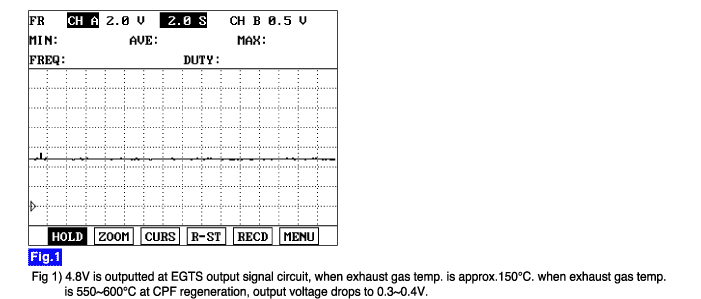

In EURO4 diesel engine with CPF, injection is devided into 2 pilot, 1 main, 2 post injections. Among these injections, pilot and main injections are for the operation of engine, however post injections are for CPF regeneration. Only in activating condition of CPF regeneration during driving, post injection starts. 1st post injection happens at the end of combustion cycle then, injected fuel is used to raise exhaust temperature. that temp. is sensed at T3 exhaust tempt. sensor which is ahead of Turbo charger. 2nd post injection happens at exhaust cycle then, injected fuel is also used to raise exhaust temperature. that temp. is sensed T5 exhaust tempt. sensor which is between Oxydation catalyst and CPF. The reason of raising exhaust tempt. is because exhaust tempt. in diesel engine is too low for CPF regeneration. The optimum tempt. for CPF regeneration is 550~600℃ thus, the goal of post injection is raise exhaust tempt. to that range of tempt.. However if exhaust tempt. is too high, turbo charger or CPF are likely to be damaged. Therefore if tempt. measured at each sensor is out of permittable value(specification), ECM deactivates CPF regeneration.
P2033 is set when rear exhaust temperature is above 890℃.
Item | Detecting Condition | Possible Cause | |
DTC Strategy | ● Voltage monitoring | ● Exhaust temp. sensor(T5-CPF) wiring ● Exhaust temp. sensor(T5-CPF) component | |
Enable Conditions | ● IG KEY "ON" | ||
Threshold Value | ● Rear exhaust temperature above 890℃ | ||
Diagnostic Time | ● 2 sec. | ||
Fail Safe | Fuel Cut | NO | ● Engine check lamp blinks. ● Temp. governing inhibited ● Soot simulation ON mode activated ● Reduced regeneration mileage |
EGR Off | NO | ||
Fuel Limit | NO | ||
Check Lamp | BLINK |
Temp.(℃) | Nominal(kΩ) | NEW | AGED | ||
Min(kΩ) | Max(kΩ) | Min(kΩ) | Max(kΩ) | ||
100 | 371 | 289 | 481 | 272 | 515 |
300 | 5.92 | 5.3 | 6.61 | 5.15 | 6.79 |
600 | 0.363 | 0.347 | 0.379 | 0.341 | 0.386 |
900 | 0.0893 | 0.0842 | 0.0949 | 0.0833 | 0.096 |
